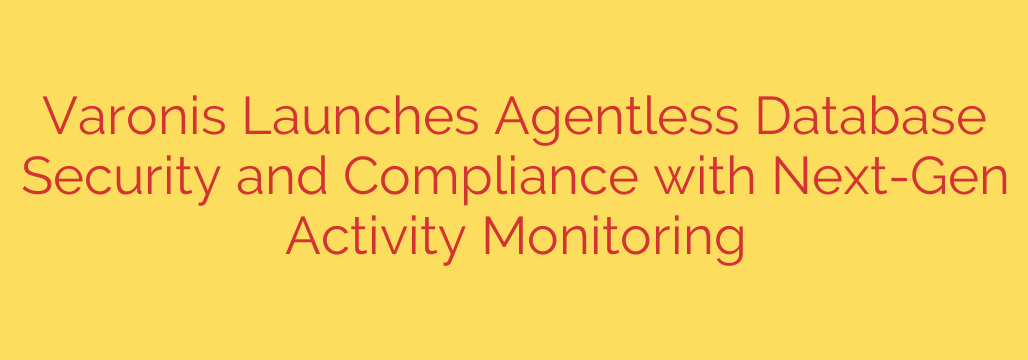
Unlock Comprehensive Database Security Without the Performance Hit: The Agentless Revolution
For years, securing the sensitive data stored in corporate databases presented IT and security teams with a difficult choice: deploy performance-draining software agents on every server or accept significant security blind spots. This trade-off often created friction between security goals and operational stability. Fortunately, a new approach is changing the game, offering robust security and compliance without the traditional overhead.
The future of database protection lies in agentless monitoring—a method that delivers deep visibility into data activity without installing any software on the databases themselves. This modern approach is critical in today’s complex, hybrid environments where data lives across on-premises data centers and multiple cloud platforms.
The Problem with Traditional Database Activity Monitoring (DAM)
Traditional DAM solutions have long been the standard, but they come with inherent challenges that modern enterprises can no longer afford to ignore. These legacy systems typically require agents, which act as gatekeepers on the database server. While effective to a degree, this architecture causes several problems:
- Performance Degradation: Agents consume CPU and memory on the database server, potentially slowing down critical business applications.
- Deployment Complexity: Installing and maintaining agents across dozens or hundreds of servers is a time-consuming and disruptive process that often requires downtime and extensive coordination with database administrators (DBAs).
- Incomplete Coverage: The difficulty of deployment often means that not all databases get monitored, leaving dangerous security gaps.
- Alert Fatigue: Older systems often generate a high volume of low-context alerts, making it difficult for security teams to identify genuine threats amidst the noise.
A New Paradigm: Agentless Security and Next-Gen Monitoring
A modern data security platform overcomes these hurdles by taking an agentless approach. Instead of living on the server, this technology captures database activity directly from network traffic and integrates it with logs and other contextual data. The result is a comprehensive, low-impact solution for total visibility.
The key is to combine multiple data streams to build a complete picture. By analyzing network protocols and pulling event logs, security teams can see every query, result set, and authentication attempt without ever touching the production database’s performance.
This method provides powerful, unified coverage across a wide range of systems, including:
- On-premises databases like SQL Server, Oracle, Postgres, and MySQL.
- Cloud-based databases such as Azure SQL, Amazon RDS, and Google Cloud SQL.
Key Benefits of an Agentless Database Security Strategy
Adopting an agentless model provides immediate and significant advantages for any organization serious about protecting its data.
Zero Impact on Database Performance
By moving monitoring off the server, you eliminate the risk of slowing down essential applications. DBAs no longer need to worry that security tools will interfere with performance, leading to smoother collaboration between security and IT operations teams.Rapid, Scalable Deployment
Without agents to install, you can stand up comprehensive monitoring for your entire database fleet in a fraction of the time. This allows you to secure new databases in the cloud or on-premises almost instantly, ensuring no asset is left unprotected.A Unified View of Your Entire Data Estate
True security requires context. An agentless solution integrated into a wider data security platform allows you to see database risks alongside threats in your cloud apps (like Salesforce and Microsoft 365) and cloud infrastructure. This single-pane-of-glass view helps you understand how an attacker might move from a compromised cloud account to your most sensitive databases.AI-Powered Threat Detection
Modern platforms don’t just log activity—they understand it. By using artificial intelligence to baseline normal user and application behavior, the system can automatically detect suspicious activity that signals a threat. This includes identifying early signs of ransomware, insider threats, and compromised service accounts that legacy systems would miss.
Actionable Steps for Enhancing Your Database Security
As you evaluate your organization’s data protection posture, consider the following best practices:
- Prioritize Agentless Solutions: Insist on security tools that do not require agents on your database servers. This will ensure operational stability, simplify management, and reduce friction within your organization.
- Demand a Unified Platform: Don’t settle for siloed security tools. A solution that connects database security with visibility into your SaaS applications and cloud infrastructure provides the necessary context to stop sophisticated threats.
- Leverage AI for Proactive Defense: Move beyond simple alerting. Choose a platform that uses machine learning to automatically detect deviations from normal behavior, allowing you to catch threats before they become full-blown breaches.
- Ensure Comprehensive Compliance Monitoring: Your security solution should make compliance easier, not harder. Ensure it can automatically generate reports for regulations like SOX, HIPAA, and PCI DSS by tracking access to sensitive and regulated data.
The way we secure data must evolve with the technology landscape. By embracing an agentless, AI-driven approach, organizations can finally achieve the robust database security and compliance they need without sacrificing performance or operational agility.
Source: https://www.helpnetsecurity.com/2025/07/29/varonis-next-gen-dam-database-activity-monitoring/








